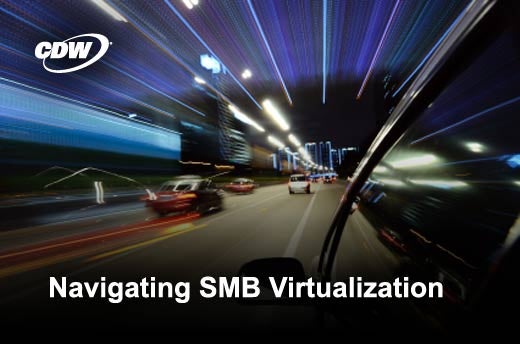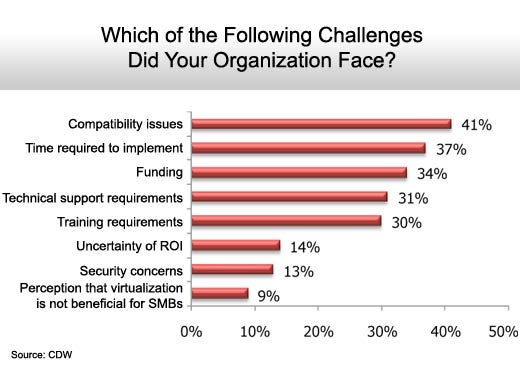How can small businesses know if virtualization is a fit? To answer this question, CDW surveyed nearly 300 small business Information Technology (IT) professionals through Spiceworks, a social network for IT, interviewing those that have and have not virtualized for their perceptions of and experiences with server virtualization.
The resulting Small Business Virtualization Roadmap examines the opportunities and challenges related to server virtualization.
Click through for virtualization opportunities and challenges identified by CDW in a recent survey conducted through Spiceworks, a social network for IT.
First ask yourself: Do you, or does anyone on your IT team, have the knowledge and expertise to perform the assessment yourself, or do you need to seek it from a third party?
Then: Using internal or third-party expertise, assess your current environment and identify your virtualization goals:
- Which of your servers, if any, are compatible with a virtualization operating system?
- Do you have a storage environment adequate to support the virtual environment? (Shared storage is highly recommended.)
- What applications reside on your servers?
- Do the software vendors support the application in a virtual environment?
- Are there certain departments or applications for which you would absolutely rule out virtualization?
- How much will the transition to virtualization cost? Do you have the budget?
- How will you measure virtualization success?
To prepare for virtualization adoption, small businesses surveyed reported taking a variety of system assessment steps, including:
- Identified candidates for virtualization – 74 percent
- Created a virtual plan – 61 percent
- Identified specific goals – 59 percent
- Identified associated costs/created a budget – 56 percent
- Obtained senior-management approval on plans and budget – 55 percent
However, there is more work to be done. Few small businesses have conducted a comprehensive assessment of what resides in their systems now, and therefore many lack the information to make good decisions about server virtualization.
Of the small businesses surveyed that have virtualized, only 39 percent have executed a data center audit. Of those researching or planning to virtualize, only 23 percent have conducted a data center audit.
System assessments are a critical first step towards virtualization. You must document your infrastructure; detail what software each server is running; look at your service contracts; and consider the space available in your data center. Do your research and really take a deep dive into what servers you have, what processers they run on and how they‘re being used. Doing this upfront work helps zero in quickly on your unique virtualization roadmap and avoids headaches later.
Successful small businesses point to virtualization training for implementation and support knowledge. Eighty-six percent of businesses that have virtualized believe their organization has the expertise (staff knowledge) in place to implement and support server virtualization. Of those considering virtualization, only 20 percent feel this way.
Small business IT managers can often find free or affordable training available through virtualization software vendors, such as free webinars or videos on vendor sites, or on YouTube, or simply from working side by side with a skilled technology partner during assessment and deployment. The software vendors also offer data center management tools that simplify management of the physical and virtual environments together.
Virtualized small businesses work with their organization‘s management to ensure they fully understand and support the investment. Ninety-six percent of management who understand server virtualization benefits support its adoption.
Of those who have virtualized, 71 percent report that their organization’s management fully understands the benefits and 84 percent fully support the adoption of server virtualization. Respondents who have not yet virtualized report 43 percent and 45 percent respectively.
To convince their organizations‘ management, small businesses highlight virtualization benefits.
How did you convince your boss to approve your server virtualization investment?
- “1. Savings in long run; 2. Lower downtime compared to our previous system; 3. Better management of resources.”
- “I focused on the rapid recoverability and specific business needs. Typically I don't go down to too low a level unless I need to. It's not about the server being physical or virtual, heck how many bosses know how many servers you have now?"
- “It pretty much sold itself, the things you can do to minimize downtime, the cost savings, the manageability, the disaster recovery options, the maturity of the product –you get the idea. Using the VMware editions comparison chart and a handy IT budget, we worked out the best bang-for-buck solution.”
- “With the old Microsoft tag line for Server 2003: Do more with less. We didn't have the physical space for more servers, so I said, ‘Why not make better use of what we have? Look at all these resources sitting there idle.‘”
- “We packaged ours with VPN rollout and an updated DR plan. This gave the management things they wanted for our organization and gave us the up-to-date tools we needed to do our job.”
– Spiceworks, a social network for IT, crowdsourced quotes
Once approved, CDW suggests the following steps:
- Finalize candidates for virtualization.
- Determine the virtualization platform.
- Determine the server hardware platform.
- Determine the storage hardware platform.
- Revisit backup/restore architecture.
- Understand server operating system licensing.
- Plan the project.
- Educate and implement.
- Leverage physical-to-virtual (P2V) conversion to the greatest degree possible.
Those small businesses that have virtualized report compatibility issues, timelines and funding as the major challenges faced during implementation.
There are a few best practices that small businesses often overlook with virtualization. They include: adopting new technology one step at a time; designing and implementing with future growth in mind; taking the time to get educated on virtualization; utilizing good project management processes; identifying what works and keep on doing it; and not letting day-to-day issues take you off track.
Small businesses rely heavily on peer support to overcome implementation challenges.
Those who have implemented server virtualization share additional lessons learned
- “The biggest lesson is to spread the project out over more time. I don't think I added any risk to my IT operations due to rolling virtualization out in a fresh install method.”
- “You can never have enough memory and you can never have enough disk space on the physical machine.”
- “I wish I had been more informed as to the variety of options out there. There are numerous options (including open source) that we were just not aware of.”
- “Contrary to popular belief, you don't need huge multi-core boxes to run virtualization or a lot of memory or storage. Sure, adding resources by the ton makes performance increase but for most companies, it is not needed. If you plan ahead (just like anything else) there will be few surprises. Every business is different so each system in the end will be different. Just like investing, do your own research.”
- “The one thing I wish someone had told me is that just because you are virtualizing things, it doesn't lift you from basic testing. Always reboot your physical host, via reset button or power cord if you can, once the system has all of its services running on it.”
CDW experts share technical execution best practices:
- Build in limits for VM sprawl. Too many VMs can hinder efficiency as well.
- Be consistent in technology purchases. While the server virtualization hypervisor and related products are not brand-specific, it‘s a smart move to be consistent in hardware brands and components.
- Allocate VMs running a variety of applications to a given host. This will amplify the network and application optimization measures in place.
- Avoid single points of failure. SANs should be linked to back one another up; redundant network interface cards (NICs) will keep a host connected should one card fail.
- Keep abreast of security developments for the virtualized world. More research is being focused on security at the hypervisor level of virtualization and thereby the improved protection of virtual machines.
- Virtualization is a means to an end, not an end in itself. The decision on whether to virtualize comes down to the resources demanded by an application.
For small businesses using virtualization, there is no question that the technology provides substantial, measurable benefits for their organizations. Of those that have virtualized, 79 percent say small businesses can see significant benefits from server virtualization, and 65 percent say server virtualization has significantly improved their organization’s IT ROI. On average, they are saving 18 percent of their IT budget due to server virtualization implementation.
Small businesses that have implemented virtualization are measuring the success of their program by more than just savings.
Hard ROI:
- Reduction of physical server count – 65 percent
- Server/storage management and support costs – 34 percent
- IT energy consumption and costs – 32 percent
- Software licensing costs – 17 percent
Soft ROI:
- Improved IT productivity (easier management) – 52 percent
- Increased uptime – 51 percent
- Increased business agility, adaptability, flexibility – 43 percent
- Data center footprint – 25 percent
CDW experts suggest looking for savings from:
- Smaller physical footprint for servers: Consuming less space can reduce a company‘s real estate costs or free up that space to be used for other purposes.
- Lower hardware costs: Virtualization improves machine utilization rates, meaning IT shops need fewer servers.
- More efficient IT administration: Once the virtualization environment is set up, administrators can quickly create and provision virtual machines through a Web browser from almost anywhere on the network, which speeds up application deployment.
- Reduced software licensing costs: You may find fewer licenses are in actual use in a virtual setup, compared with what might have been required in an application-per-server physical environment.
- Improved power and cooling efficiency: By reconfiguring cooling and concentrating it where it‘s most needed, the system uses less total energy to remove hot air.

















